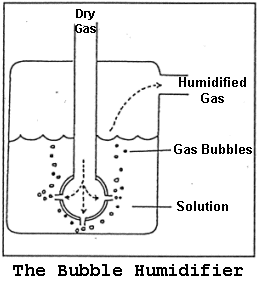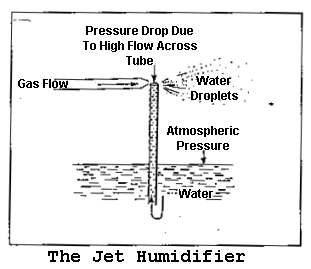|
Principles of Humidification |
Humidification Devices
The effectiveness of humidifiers ability to adequately supply vapor to a gas depends on three factors: temperature, surface area and time.
Temperature increases cause increases in vapor pressure and potential humidity. The greater the surface area of water/gas contact and the longer time this contact takes place, the greater the number of water molecules that can enter the gas mixture. These principles are used by humidifiers to provide increased relative humidity to the gas.
Blow-By Humidifier

|
Figure 1. The blow-by humidifier.
The purpose of humidifiers is to deliver a gas with a maximum amount of water vapor content. These humidifiers may be heated or unheated, and the factors affecting the efficiency of humidification devices include:
- temperature
- time of exposure between gas and water
- and the surface area involved in the gas/water contact
As temperature rises, the force exerted by the water molecules increases, enabling their escape into the gas, adding to the humidity. Longer exposure of a gas to the water increases the opportunity for the water molecules to evaporate during the humidifier's operation.
The pass-over type humidifier directs a dry gas source over a water surface area, and flowing it to the patient. Because exposure area and time of contact is limited and it is not heated, this unit is not very efficient. These units are often used in incubators and in certain ventilators, although many times the use of a heated element is added to improve this humidification system (see Figure 1).
Bubble Diffusion Humidifier
This type of system (see Figure 2) uses conduction to introduce the gas into the water below its surface. The gas passes through the liquid in the form of bubbles of various sizes. This is more effective because it increases exposure time and contact area. These units are called diffusers. The bubble or diffuser-type humidifiers are most commonly used.
The ability to hold water vapor falls as the temperature of gas falls, with room temperature's relative humidity falling between 30 and 50%. Since a very low water content actually reaches the patient, this type of humidification is not recommended for patients with an endotracheal tube, tracheostomy or tenacious secretions. Gas flow through these humidifiers affects humidity. The higher the flow rate of a gas, the less the exposure time to the airway. These units function best at a flow rate of 2 liters/minute and should not be run at greater than 6 liters/minute.

|
Figure 2. The bubble humidifier.
Jet Humidifier
This type of humidifier actually forms an aerosol, but employs baffles to break the particles into small droplets, allowing them to evaporate. The gas is humidified further before it leaves the unit. The aerosol is formed by Bernoulli's principle. A low pressure zone at the top of the water inlet tube draws water into the jet stream and the water is then aerosolized by the flow of gas.

|
Figure 3: Jet humidifier
Bernoulli's principle is employed as follows: Gas flows into the chamber through a restricted orifice, causing a high velocity flow which passes across a capillary tube that is immersed in water. The pressure drops around the opening of the capillary tube and water is forced up the capillary tube. The jet stream of air blows the liquid off in small particles as it reaches the top of the capillary tube.
The jet humidifier produces a high humidity output by employing Bernoulli's principle to form an aerosol and using baffles to break up the particles.

|
Figure 4. Underwater Jet Humidifier
The underwater jet humidifier utilizes the principles of two other humidifiers: the bubble and the jet humidifiers. In the underwater jet, the restricted orifice and capillary tube are both below the surface of the water. The aerosolized gas then bubbles through the water, increasing surface area and water/gas contact time, increasing efficiency.
Heated Humidifier
These humidifiers are indicated when it is necessary to deliver a humidified gas directly to the tracheobronchial tree (for example if the patient has a tracheostomy tube or an intubation tube), bypassing the natural humidification and heating system (nasal pharyngeal route). The gas must be delivered at 100% relative humidity at body temperature.
These devices (like the Cascade humidifier) incorporate a bubble pass-over type of system. Gas is moved down a tower, passes through a grid that has a thin layer of water covering it and then over the warm water before being expelled out of the unit and more humidification takes place. This humidifier can deliver 100% relative humidity at various temperatures.
These humidifiers can go well above body temperature, creating the potential for tracheal burns or possible aspiration if tubing is not drained frequently. Wide bore tubing should always be used with thes humidifiers, and be sure to humidify the gas during delivery.